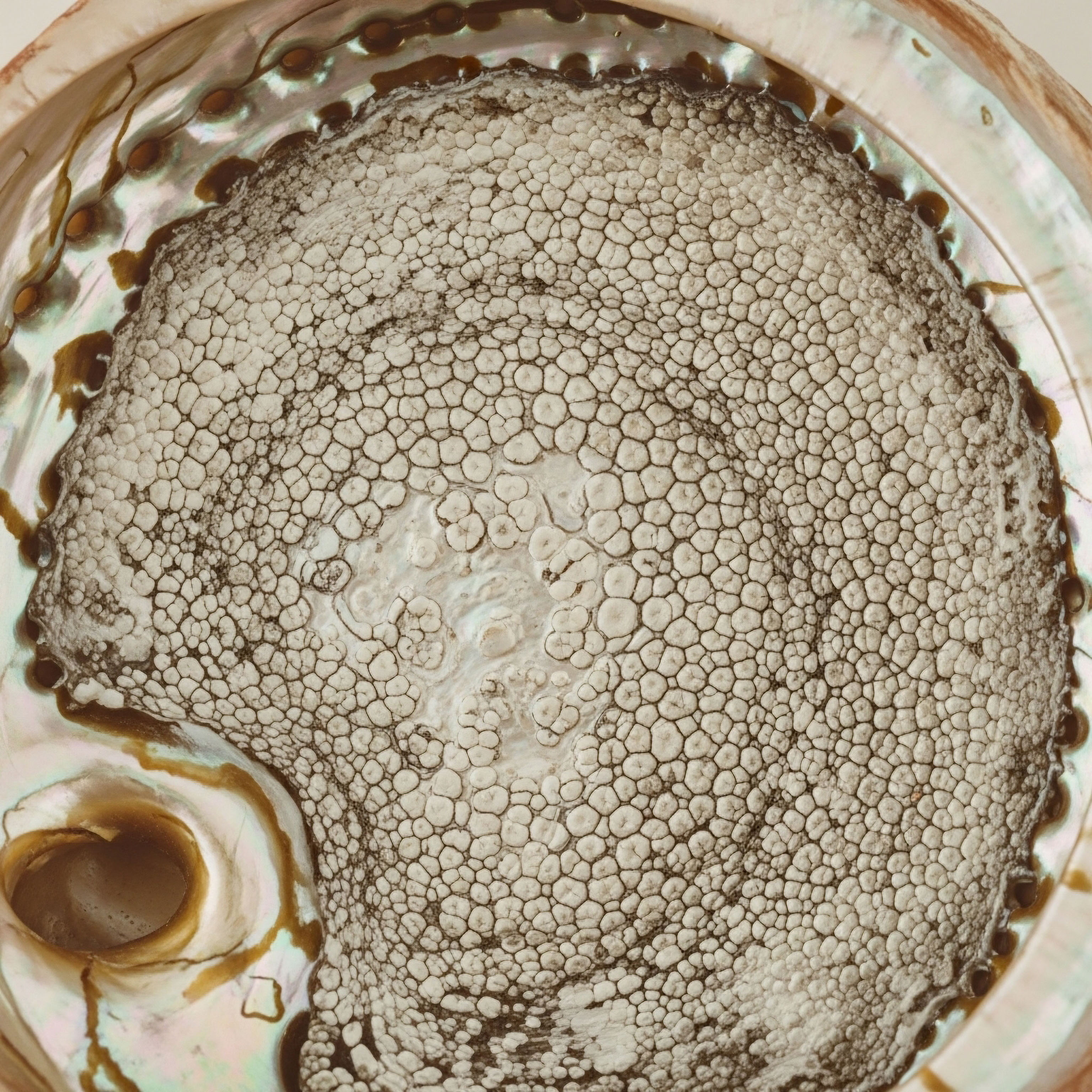

Fundamentals
The experience of a decline in sexual vitality is often felt as a quiet, personal loss. It can manifest as a subtle fading of color from a once-vibrant aspect of life, leaving a sense of disconnect from a core part of oneself.
This feeling, this lived reality, is a valid and significant signal from your body. It is an invitation to understand the intricate biological systems that govern desire, arousal, and connection. The journey toward reclaiming this vitality begins with a shift in perspective, moving from the periphery of the body to its central command center ∞ the brain.
Sexual function is an expression of neurological and endocrine health. It is a symphony conducted by the brain, where specific molecules act as messengers that initiate the cascade of events we experience as desire.
One of the most profound discoveries in this field is the role of the melanocortin system, a network within the central nervous system that functions as a primary circuit for sexual motivation. This system operates independently of the more commonly understood vascular pathways. It is the spark, the initial impulse that originates deep within the brain’s architecture.
Understanding sexual response begins with recognizing its origin as a neurological event, orchestrated within the brain’s complex signaling networks.

The Brain as the Epicenter of Desire
For decades, the conversation around sexual dysfunction has centered on mechanical and circulatory issues. This model, while useful, is incomplete. It addresses the orchestra’s instruments while overlooking the conductor. True sexual vitality arises from a confluence of factors, with the brain’s interpretation of internal and external cues being paramount. When the brain’s signaling pathways are robust, the body responds. When they are muted, the entire system can feel offline.
Peptide therapies represent a sophisticated approach that honors this principle. Certain peptides are designed to communicate directly with these central command centers. They are molecular keys designed to fit specific locks within the brain, reopening pathways that may have become dormant. This approach is about restoring a fundamental line of communication within your own biology, reminding the system of a function it already knows.

What Are Peptides?
Peptides are short chains of amino acids, the building blocks of proteins. In the body, they act as highly specific signaling molecules, instructing cells and systems to perform particular functions. Hormones like insulin are peptides. Neurotransmitters can be peptides. They are the language of cellular communication.
Therapeutic peptides are synthesized to mimic or modulate these natural signals with high precision. This specificity allows them to target distinct biological pathways, such as the melanocortin system for sexual desire or the pituitary gland for growth hormone release, which underpins overall cellular health and energy.

The Supportive Role of Systemic Vitality
While specific brain circuits ignite desire, the body’s overall condition determines the quality and sustainability of the flame. This is where another class of peptide therapies, growth hormone secretagogues, plays a vital role. These peptides do not directly create desire; they work by encouraging the body’s own production of growth hormone.
An optimized growth hormone axis contributes to improved energy levels, better sleep quality, enhanced lean muscle mass, and a more resilient metabolism. These are the foundational pillars of wellness upon which a healthy sexual life is built. A body functioning with vitality is a body that has the resources to allocate toward sexual health.
This dual approach, targeting both the specific neurological spark and the general systemic environment, represents a comprehensive model for reclaiming function. It is a process of tuning both the conductor and the instruments, allowing the symphony of sexual health to be played with clarity and strength once more.


Intermediate
Advancing from a foundational understanding of sexual function’s neurological origins, we can examine the specific tools used to modulate these systems. Peptide therapies in this domain are divided into two primary categories based on their mechanism of action.
The first directly targets the neural circuits of desire, while the second works to optimize the body’s systemic environment, creating a foundation upon which sexual health can be built. A grasp of these distinct protocols is essential for appreciating their long-term potential.

Direct Neurological Activation PT-141
PT-141, known clinically as Bremelanotide, is a synthetic peptide that acts as an agonist for melanocortin receptors in the brain, particularly the MC3R and MC4R. Its function is to directly stimulate the pathways responsible for sexual motivation. The U.S.
Food and Drug Administration (FDA) has approved Bremelanotide for the treatment of hypoactive sexual desire disorder (HSDD) in premenopausal women, a condition characterized by a distressing lack of sexual desire. Its use in men for erectile dysfunction and low libido is considered off-label but is based on the same central mechanism.
The peptide is administered via subcutaneous injection, typically 45 minutes before anticipated sexual activity. Its action bypasses the vascular system, making its mechanism fundamentally different from phosphodiesterase type 5 (PDE5) inhibitors. This central action involves increasing dopamine release in key brain regions, which is directly linked to motivation and the experience of desire.

How Does PT-141 Differ from Traditional ED Medications?
A clear distinction between these therapeutic classes is critical for understanding their application. PDE5 inhibitors facilitate the mechanical aspects of sexual function, while PT-141 addresses the motivational component.
| Feature | PT-141 (Bremelanotide) | PDE5 Inhibitors (e.g. Sildenafil) |
|---|---|---|
| Primary Mechanism | Acts on melanocortin receptors in the central nervous system to increase sexual desire. | Increases blood flow to the genitals by inhibiting the PDE5 enzyme. |
| Primary Effect | Initiates libido and sexual motivation. | Facilitates and sustains penile erection. |
| Affected System | Central Nervous System (Brain). | Peripheral Vascular System. |
| Use Case | Low desire (HSDD), motivational deficits, or ED unresponsive to PDE5 inhibitors. | Erectile dysfunction with intact sexual desire. |
| Onset of Action | Approximately 45 minutes to an hour. | Approximately 30-60 minutes. |

Systemic Optimization Growth Hormone Secretagogues
A separate class of peptides, known as growth hormone secretagogues (GHS), contributes to sexual health indirectly by enhancing overall physiological function. These peptides stimulate the pituitary gland to produce and release the body’s own growth hormone (GH). This is distinct from direct injection of synthetic HGH, as it preserves the body’s natural, pulsatile release patterns. Enhanced GH levels, and subsequently Insulin-like Growth Factor-1 (IGF-1) levels, support a cascade of benefits that are foundational to sexual wellness.
Growth hormone secretagogues support sexual function by improving systemic health markers like energy, body composition, and circulation.
These benefits include improved energy metabolism, enhanced sleep quality, increased lean body mass, and better tissue repair. For sexual function, this translates to having the physical stamina and metabolic resources necessary for a healthy libido and performance. Furthermore, GH has been shown to improve circulation, which benefits both male and female sexual organs by enhancing sensitivity and function.
- Sermorelin ∞ A GHRH analog that mimics the body’s natural growth hormone-releasing hormone, promoting a gentle, rhythmic release of GH.
- Ipamorelin / CJC-1295 ∞ This combination provides a more sustained and potent stimulus for GH release. Ipamorelin is a selective GH secretagogue that mimics ghrelin, while CJC-1295 is a GHRH analog with a longer half-life. Together, they create a powerful synergistic effect.
- Tesamorelin ∞ Another GHRH analog, specifically studied for its potent effects on reducing visceral adipose tissue, which can improve metabolic health and hormonal balance.
The long-term outcome of GHS therapy on sexual function is tied to the long-term improvement of these foundational health parameters. It is a strategy of rebuilding the entire system to better support all its functions, including sexual vitality.


Academic
A sophisticated examination of the long-term outcomes of peptide therapies on sexual function requires a deep analysis of their distinct neurophysiological and endocrine pathways. The durability of their effects and their safety profiles are contingent upon these mechanisms. We will analyze the central melanocortin pathway targeted by PT-141 and the systemic Hypothalamic-Pituitary-Somatotropic (HPS) axis modulated by growth hormone secretagogues.

The Melanocortin System and Neuro-Sexual Signaling
PT-141 (Bremelanotide) is a biomimetic of alpha-melanocyte-stimulating hormone (α-MSH) and functions as a potent agonist at the melanocortin-3 (MC3R) and melanocortin-4 (MC4R) receptors within the central nervous system. These receptors are densely expressed in hypothalamic and limbic regions, including the paraventricular nucleus (PVN) and medial preoptic area (mPOA), which are critical integration centers for sexual behavior.
The binding of Bremelanotide to these receptors initiates a downstream signaling cascade that modulates the release of neurotransmitters, chiefly dopamine. This dopaminergic activity is central to the brain’s reward and motivation circuitry, providing the neurochemical basis for what is subjectively experienced as libido or desire.

What Does Long-Term Clinical Data Reveal about Bremelanotide?
The long-term efficacy and safety of Bremelanotide have been evaluated in the RECONNECT studies, which included an open-label extension phase. These trials provide the most robust data available on sustained use. The studies demonstrated a statistically significant improvement in the Female Sexual Function Index-desire domain (FSFI-D) and a reduction in the Female Sexual Distress Scale ∞ Desire/Arousal/Orgasm (FSDS-DAO) score. These effects were maintained throughout the extension phase for patients continuing the therapy.
However, the data also illuminate the primary challenge of this therapy ∞ adverse events. The most common treatment-emergent adverse events are nausea (approximately 40%), flushing (20%), and headache (12%). These side effects were a significant cause for treatment discontinuation, with rates around 25% for patients newly initiated on the therapy in the extension phase.
This suggests that while the mechanism is effective for a subset of the population, its long-term viability is contingent on individual tolerability. There was no evidence of cumulative or sustained effects on blood pressure, with observed increases being small and transient.
Long-term data for Bremelanotide confirm its sustained efficacy on desire, with tolerability of side effects like nausea being the primary determinant of continued use.

The HPS Axis and Indirect Effects on Gonadal Function
Growth hormone secretagogues (GHS) like Sermorelin and Ipamorelin operate on a different biological axis. They stimulate GHRH receptors in the anterior pituitary, leading to an endogenous pulse of growth hormone (GH). This GH then stimulates the liver and other tissues to produce IGF-1.
The long-term effects of this therapy on sexual function are mediated through the systemic benefits of optimizing the GH/IGF-1 axis. Research indicates that GH can improve the sensitivity of gonadotropins and play a role in testicular steroidogenesis and ovarian function. It influences erectile function and female sexual response through improvements in endothelial function, nitric oxide availability, and overall energy metabolism.

Are There Long-Term Risks Associated with GHS Therapy?
The long-term safety profile of GHS is an area of ongoing investigation. Because these therapies promote the body’s own production of GH within physiological ranges, they are considered to have a more favorable safety profile than direct administration of exogenous HGH.
Direct HGH administration is associated with risks of hyperglycemia, edema, arthralgia, and potentially an increased risk of certain malignancies. GHS therapies, by preserving the natural feedback loops of the HPS axis, mitigate some of these risks. The most common side effects are generally mild and include injection site reactions, transient flushing, and headaches.
The primary long-term consideration is the potential for altering hormonal balance. Overstimulation of the HPS axis could theoretically lead to downstream effects on other endocrine systems. Therefore, long-term use requires careful medical supervision, including periodic laboratory assessments of IGF-1 levels to ensure they remain within an optimal, safe range. The absence of large-scale, multi-year clinical trials for many GHS compounds means that current understanding is based on smaller studies and clinical experience.
| Peptide Class | Primary Long-Term Outcome | Key Long-Term Consideration | Primary Supporting Data |
|---|---|---|---|
| Melanocortin Agonists (PT-141) | Sustained improvement in centrally-mediated sexual desire. | Tolerability of acute side effects (nausea, flushing) determines adherence. | RECONNECT Studies (Phase 3 Trials). |
| Growth Hormone Secretagogues (GHS) | Indirect improvement in sexual function via enhanced systemic vitality, energy, and circulation. | Maintaining hormonal balance (IGF-1 levels) within a safe physiological range requires monitoring. | Smaller clinical studies and physiological principles. |

References
- Kingsberg, S. A. et al. “Long-Term Safety and Efficacy of Bremelanotide for Hypoactive Sexual Desire Disorder.” Obstetrics & Gynecology, vol. 134, no. 5, 2019, pp. 899-908.
- Pfaus, J. et al. “Bremelanotide ∞ an overview of preclinical CNS effects on female sexual function.” The Journal of Sexual Medicine, vol. 4, supplement 4, 2007, pp. 269-79.
- Simon, J. A. et al. “Efficacy and safety of bremelanotide for the treatment of premenopausal women with hypoactive sexual desire disorder ∞ a pooled analysis of the RECONNECT studies.” The Journal of Sexual Medicine, vol. 16, no. 10, 2019, pp. 1595-1604.
- Molitch, M. E. et al. “Evaluation and treatment of adult growth hormone deficiency ∞ an Endocrine Society clinical practice guideline.” The Journal of Clinical Endocrinology & Metabolism, vol. 96, no. 6, 2011, pp. 1587-609.
- Rask, E. et al. “Effects of 12 months of treatment with growth hormone and/or testosterone in obese men with verified hypogonadism.” The Journal of Clinical Endocrinology & Metabolism, vol. 91, no. 2, 2006, pp. 441-8.
- Hadley, M.E. “Discovery that a melanocortin regulates sexual functions in male and female humans.” Peptides, vol. 26, no. 10, 2005, pp. 1687-9.
- Van der Lely, A. J. et al. “Long-term safety of pegvisomant in patients with acromegaly ∞ a post-marketing surveillance study.” The Lancet Diabetes & Endocrinology, vol. 2, no. 1, 2014, pp. 46-54.
- Arlt, W. & R. J. Auchus. “Adrenal insufficiency.” The Lancet, vol. 391, no. 10137, 2018, pp. 2356-2369.
- Clayton, P. E. et al. “Consensus statement on the management of the long-term effects of growth hormone therapy.” European Journal of Endocrinology, vol. 152, no. 2, 2005, pp. 165-70.
- Rosen, T. & B. A. Bengtsson. “Premature mortality due to cardiovascular disease in hypopituitarism.” The Lancet, vol. 336, no. 8710, 1990, pp. 285-8.

Reflection
The information presented here offers a map of the biological territories that govern sexual function. It details the pathways, signals, and systems that contribute to this vital aspect of human experience. This knowledge provides a framework for understanding your own body with greater clarity and precision. It transforms vague feelings of change into specific, addressable biological questions.

Where Do You Locate Yourself on This Map?
Consider the distinction between the central spark of desire and the systemic capacity for performance. Reflect on your own experience. Is the primary challenge a quietening of internal motivation, a feeling that the initial impulse is absent? Or is it a matter of physical energy, stamina, and response, where the desire is present but the body feels unable to fully participate?
Your personal answers to these questions are the starting point of a more targeted and effective conversation about your health.
This clinical science is not an endpoint. It is a powerful tool for self-awareness and a catalyst for a deeper dialogue with a qualified medical professional who can help translate this knowledge into a personalized protocol. The journey to reclaiming vitality is yours alone, but it does not need to be navigated without a guide and a compass.

Glossary

sexual function

central nervous system

peptide therapies

growth hormone

sexual desire

growth hormone secretagogues

bremelanotide

pt-141

hypoactive sexual desire disorder

hsdd

pde5 inhibitors

hormone secretagogues

sermorelin

ipamorelin

cjc-1295

nervous system

mc4r

side effects

long-term safety




